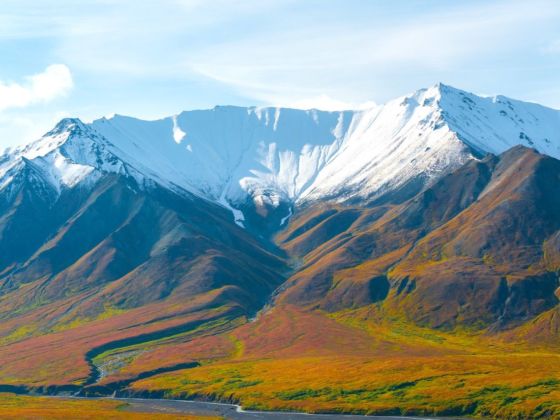

Denali means “the high one” in the Indigenous Athabascan language. It’s also often referred to simply as “the mountain.” At 20,308 feet — and rising — it stands alone as the highest peak on the continent, emerging uniquely above the 600-mile Alaskan Range. Spruce and quaking aspen pop out of the marshy taiga, mountain avens, heath, and willow shrubs underfoot as far as the eye can see.
And the eye can see far. The “Yellowstone of Alaska” is a misnomer; here, there is not a single boardwalk, not a single overcrowded parking lot, not a single fancy readerboard-lined trail. Denali National Park is three times the size of Yellowstone, and standing over Polychrome Pass — miles of wilderness so fragile the heat of your gaze seems dangerous — the immensity will strike you. Places like this do not exist in the Lower 48.
If you’re lucky enough to find yourself here, counting Dall sheep from a viewpoint or counting steps into the backcountry, here’s what to do.
“Summer” — the only season in Denali where all facilities are open to the public — is May 20 to mid-September. As with any wilderness location, the “when to go” isn’t always that simple, however. Late May and early June may see rain or snow and thus closures. Late June is when the weather gets warmer and drier, but the crowds ramp up and so do the mosquitoes. July and August is peak tourist season (despite the mosquitoes) as the weather tends to be dry and clear; in September, the crowds start to dwindle, and the autumn foliage rages in golds and reds, but weather and precipitation are unpredictable.
April-May and September-October can be highly rewarding times to visit. The weather may still be surprisingly temperate (year depending), the crowds are all but gone, and your chance to see the northern lights is at its highest. From October to March, you’re looking at skiing, snowshoeing, and winter biking...and temperatures from 20 to minus 40 degrees Fahrenheit.
Technically, the park is open year-round (with no gate), but bus service ceases and the park road is only maintained until mile 15 in the off-season. Riley Creek campground at mile 0.4 is open year-round, though all other campgrounds and backcountry lodges are closed.
While you could rent a car to get to Denali, you’ll get little use out of it once you’ve arrived. A far more memorable — and classic — option is taking the Alaska Railroad. You can hitch a ride either north from Anchorage or south from Fairbanks, and it’ll drop you right off in Denali at mile 1.25 within walking distance of the Denali Visitor Center. There’s an observation car and several outdoor viewing platforms to take in views of the Chugach Mountains, though the wide, seat-to-ceiling windows in the main cars do the job themselves. The train stops in Denali twice daily.
Those arriving from Fairbanks have the option to take the railroad into and out of the park on the same day. The first train arrives at noon from Fairbanks and the second departs at 4:00 PM to Fairbanks. With zero stops, the ride from Anchorage to Denali is eight hours long while the Fairbanks to Denali train is roughly four hours.
A common option for those traveling from Anchorage is to break up the journey halfway by stopping in Talkeetna for the night, perhaps staying at the Talkeetna Alaskan Lodge. You’ll mill around the town’s mining-era main street, try Shirley’s famous bright-pink fireweed ice cream, and resume the four-hour ride to Denali the next day.
And then there’s getting back. You could take a transit or tour bus both in and out the same day, or you could stay at a backcountry lodge or campground and hitch a ride back when your stay is complete. Alternatively, you can fly out. The folks at Kantishna Air Taxi offer rides and flightseeing tours out of the park.
There is one road in and out of Denali, and it’s 92 miles long — roughly six hours — one way. Personal vehicles are stopped at mile 15; free courtesy shuttles also run up until this point. If you want to get in further, you either have to hoof it on foot or hop on a transit, tour, or camper bus.
A transit bus is best if you’re looking to hike, picnic, catch a specific photo, or just explore on your own. The farthest transit bus goes out to mile 85. These depart from the bus depot and will pick you up along the road when you’re ready to return to the front country.
Tour buses, on the other hand, are just that: tours. They’re meant for those who want a narrated experience and a convenient way to see the park. They are not hop-on, hop-off though they do stop at designated viewpoints and restrooms and for wildlife. Both tour and transit buses offer trips of varying distances and durations.
Camper buses are, obviously, meant for campers. Tickets are required, and you can make pick-up requests at the bus depot on your way to your campground.
If you’d like a tour through the entire length of the park in a single day, check out Denali Backcountry Adventure. They’ll pick you up from your lodging outside the park at 6:00 AM, narrate your adventure through the park, provide lunch in Kantishna, and get you back by 7:30 PM.
A little Northern Exposure never hurt anyone.
The perfect blend of epic wildlife and cozy comfort.
Don't feel like hiking? We got you covered.
You can't beat this place.
It’s only accessible by plane.
Is there a better way to get around?
Parks in the lower 48 get pretty crowded. Denali, not so much.